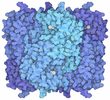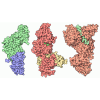+ Open data
Open data
- Basic information
Basic information
| Entry | Database: PDB / ID: 8oth | |||||||||
|---|---|---|---|---|---|---|---|---|---|---|
| Title | TypeII tau filament from Kii ALS/PDC | |||||||||
 Components Components | Microtubule-associated protein tau | |||||||||
 Keywords Keywords | PROTEIN FIBRIL / TypeII tau filaments / Kii ALS/PDC | |||||||||
| Function / homology |  Function and homology information Function and homology informationplus-end-directed organelle transport along microtubule / histone-dependent DNA binding / negative regulation of establishment of protein localization to mitochondrion / positive regulation of protein localization to synapse / neurofibrillary tangle / microtubule lateral binding / axonal transport / main axon / phosphatidylinositol bisphosphate binding / tubulin complex ...plus-end-directed organelle transport along microtubule / histone-dependent DNA binding / negative regulation of establishment of protein localization to mitochondrion / positive regulation of protein localization to synapse / neurofibrillary tangle / microtubule lateral binding / axonal transport / main axon / phosphatidylinositol bisphosphate binding / tubulin complex / regulation of long-term synaptic depression / negative regulation of tubulin deacetylation / generation of neurons / regulation of chromosome organization / rRNA metabolic process / axonal transport of mitochondrion / regulation of mitochondrial fission / axon development / intracellular distribution of mitochondria / central nervous system neuron development / regulation of microtubule polymerization / microtubule polymerization / minor groove of adenine-thymine-rich DNA binding / lipoprotein particle binding / dynactin binding / negative regulation of mitochondrial membrane potential / glial cell projection / apolipoprotein binding / axolemma / protein polymerization / negative regulation of mitochondrial fission / Caspase-mediated cleavage of cytoskeletal proteins / regulation of microtubule polymerization or depolymerization / positive regulation of axon extension / neurofibrillary tangle assembly / regulation of microtubule cytoskeleton organization / cytoplasmic microtubule organization / regulation of cellular response to heat / Activation of AMPK downstream of NMDARs / synapse assembly / positive regulation of protein localization / axon cytoplasm / regulation of calcium-mediated signaling / supramolecular fiber organization / somatodendritic compartment / cellular response to brain-derived neurotrophic factor stimulus / stress granule assembly / positive regulation of microtubule polymerization / phosphatidylinositol binding / nuclear periphery / positive regulation of superoxide anion generation / protein phosphatase 2A binding / regulation of autophagy / cellular response to reactive oxygen species / astrocyte activation / Hsp90 protein binding / microglial cell activation / synapse organization / cellular response to nerve growth factor stimulus / response to lead ion / PKR-mediated signaling / protein homooligomerization / regulation of synaptic plasticity / SH3 domain binding / memory / microtubule cytoskeleton organization / cytoplasmic ribonucleoprotein granule / neuron projection development / microtubule cytoskeleton / cell-cell signaling / single-stranded DNA binding / actin binding / protein-folding chaperone binding / cell body / cellular response to heat / growth cone / double-stranded DNA binding / microtubule binding / protein-macromolecule adaptor activity / microtubule / sequence-specific DNA binding / dendritic spine / amyloid fibril formation / learning or memory / neuron projection / nuclear speck / membrane raft / axon / negative regulation of gene expression / neuronal cell body / dendrite / DNA damage response / protein kinase binding / enzyme binding / mitochondrion / DNA binding / RNA binding / extracellular region / identical protein binding / nucleus Similarity search - Function | |||||||||
| Biological species |  Homo sapiens (human) Homo sapiens (human) | |||||||||
| Method | ELECTRON MICROSCOPY / helical reconstruction / cryo EM / Resolution: 3.4 Å | |||||||||
 Authors Authors | Qi, C. / Yang, S. / Scheres, S.H.W. / Goedert, M. | |||||||||
| Funding support |  United Kingdom, 2items United Kingdom, 2items
| |||||||||
 Citation Citation |  Journal: Proc Natl Acad Sci U S A / Year: 2023 Journal: Proc Natl Acad Sci U S A / Year: 2023Title: Tau filaments from amyotrophic lateral sclerosis/parkinsonism-dementia complex adopt the CTE fold. Authors: Chao Qi / Bert M Verheijen / Yasumasa Kokubo / Yang Shi / Stephan Tetter / Alexey G Murzin / Asa Nakahara / Satoru Morimoto / Marc Vermulst / Ryogen Sasaki / Eleonora Aronica / Yoshifumi ...Authors: Chao Qi / Bert M Verheijen / Yasumasa Kokubo / Yang Shi / Stephan Tetter / Alexey G Murzin / Asa Nakahara / Satoru Morimoto / Marc Vermulst / Ryogen Sasaki / Eleonora Aronica / Yoshifumi Hirokawa / Kiyomitsu Oyanagi / Akiyoshi Kakita / Benjamin Ryskeldi-Falcon / Mari Yoshida / Masato Hasegawa / Sjors H W Scheres / Michel Goedert /     Abstract: The amyotrophic lateral sclerosis/parkinsonism-dementia complex (ALS/PDC) of the island of Guam and the Kii peninsula of Japan is a fatal neurodegenerative disease of unknown cause that is ...The amyotrophic lateral sclerosis/parkinsonism-dementia complex (ALS/PDC) of the island of Guam and the Kii peninsula of Japan is a fatal neurodegenerative disease of unknown cause that is characterized by the presence of abundant filamentous tau inclusions in brains and spinal cords. Here, we used electron cryo-microscopy to determine the structures of tau filaments from the cerebral cortex of three cases of ALS/PDC from Guam and eight cases from Kii, as well as from the spinal cord of two of the Guam cases. Tau filaments had the chronic traumatic encephalopathy (CTE) fold, with variable amounts of Type I and Type II filaments. Paired helical tau filaments were also found in three Kii cases and tau filaments with the corticobasal degeneration fold in one Kii case. We identified a new Type III CTE tau filament, where protofilaments pack against each other in an antiparallel fashion. ALS/PDC is the third known tauopathy with CTE-type filaments and abundant tau inclusions in cortical layers II/III, the others being CTE and subacute sclerosing panencephalitis. Because these tauopathies are believed to have environmental causes, our findings support the hypothesis that ALS/PDC is caused by exogenous factors. | |||||||||
| History |
|
- Structure visualization
Structure visualization
| Structure viewer | Molecule:  Molmil Molmil Jmol/JSmol Jmol/JSmol |
|---|
- Downloads & links
Downloads & links
- Download
Download
| PDBx/mmCIF format |  8oth.cif.gz 8oth.cif.gz | 105.1 KB | Display |  PDBx/mmCIF format PDBx/mmCIF format |
|---|---|---|---|---|
| PDB format |  pdb8oth.ent.gz pdb8oth.ent.gz | 68.9 KB | Display |  PDB format PDB format |
| PDBx/mmJSON format |  8oth.json.gz 8oth.json.gz | Tree view |  PDBx/mmJSON format PDBx/mmJSON format | |
| Others |  Other downloads Other downloads |
-Validation report
| Summary document |  8oth_validation.pdf.gz 8oth_validation.pdf.gz | 1.3 MB | Display |  wwPDB validaton report wwPDB validaton report |
|---|---|---|---|---|
| Full document |  8oth_full_validation.pdf.gz 8oth_full_validation.pdf.gz | 1.3 MB | Display | |
| Data in XML |  8oth_validation.xml.gz 8oth_validation.xml.gz | 30.8 KB | Display | |
| Data in CIF |  8oth_validation.cif.gz 8oth_validation.cif.gz | 42.4 KB | Display | |
| Arichive directory |  https://data.pdbj.org/pub/pdb/validation_reports/ot/8oth https://data.pdbj.org/pub/pdb/validation_reports/ot/8oth ftp://data.pdbj.org/pub/pdb/validation_reports/ot/8oth ftp://data.pdbj.org/pub/pdb/validation_reports/ot/8oth | HTTPS FTP |
-Related structure data
| Related structure data |  17179MC  8ot6C  8ot9C  8otcC  8otdC  8oteC  8otfC  8otgC  8otiC  8otjC C: citing same article ( M: map data used to model this data |
|---|---|
| Similar structure data | Similarity search - Function & homology  F&H Search F&H Search |
- Links
Links
- Assembly
Assembly
| Deposited unit | 
|
|---|---|
| 1 |
|
- Components
Components
| #1: Protein | Mass: 45919.871 Da / Num. of mol.: 5 / Source method: isolated from a natural source / Source: (natural)  Homo sapiens (human) / References: UniProt: P10636 Homo sapiens (human) / References: UniProt: P10636 |
|---|
-Experimental details
-Experiment
| Experiment | Method: ELECTRON MICROSCOPY |
|---|---|
| EM experiment | Aggregation state: FILAMENT / 3D reconstruction method: helical reconstruction |
- Sample preparation
Sample preparation
| Component | Name: TypeII tau filaments from Kii ALS/PDC / Type: COMPLEX / Entity ID: all / Source: NATURAL |
|---|---|
| Source (natural) | Organism:  Homo sapiens (human) Homo sapiens (human) |
| Buffer solution | pH: 7.4 |
| Specimen | Embedding applied: NO / Shadowing applied: NO / Staining applied: NO / Vitrification applied: YES |
| Vitrification | Cryogen name: ETHANE |
- Electron microscopy imaging
Electron microscopy imaging
| Experimental equipment |  Model: Titan Krios / Image courtesy: FEI Company |
|---|---|
| Microscopy | Model: FEI TITAN KRIOS |
| Electron gun | Electron source:  FIELD EMISSION GUN / Accelerating voltage: 300 kV / Illumination mode: FLOOD BEAM FIELD EMISSION GUN / Accelerating voltage: 300 kV / Illumination mode: FLOOD BEAM |
| Electron lens | Mode: BRIGHT FIELD / Nominal defocus max: 2000 nm / Nominal defocus min: 1000 nm |
| Image recording | Electron dose: 40 e/Å2 / Film or detector model: GATAN K3 (6k x 4k) |
- Processing
Processing
| Image processing | Details: TypeII tau filament from Kii ALS/PDC |
|---|---|
| CTF correction | Type: NONE |
| Helical symmerty | Angular rotation/subunit: 179.36 ° / Axial rise/subunit: 2.39 Å / Axial symmetry: C1 |
| 3D reconstruction | Resolution: 3.4 Å / Resolution method: FSC 0.143 CUT-OFF / Num. of particles: 33337 / Symmetry type: HELICAL |
 Movie
Movie Controller
Controller












 PDBj
PDBj




